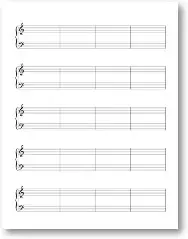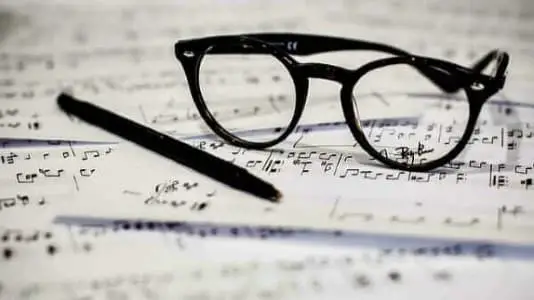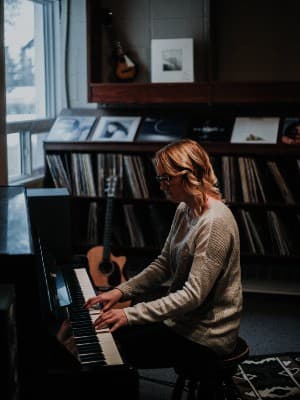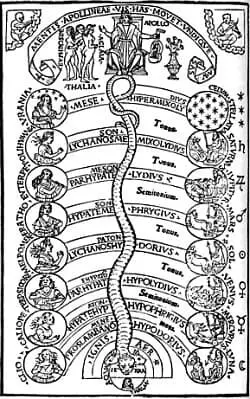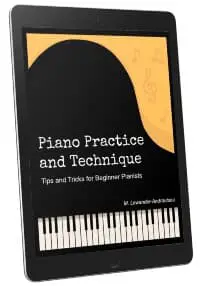- Home
- How to Write Music
- How to Write Songs
How to Write Songs
This article may contain compensated links. Please read the disclosure for more info.
In this lesson, you'll get tips on how to write songs with simple examples. You'll learn more about the different parts that make up a song and how to use the same ideas to compose your music!
How to Write Songs for Beginners
There are many ways to learn how to compose music. Nothing is right or wrong as long as it sounds good and works for you. I hope you'll get inspired to give it a try yourself!
Here we learn how to write songs by studying the different parts that are commonly used in popular melody writing. You can use any instrument, but learning how to write songs on a piano may be the easiest!
Tip: Make sure to print out some of my free printable staff paper before you begin!
Sharpen your pencil, and practice to write the notes, clefs etc. as you learn about them. This will make everything you learn here easier to remember.
Should You Write Lyrics or Melody First?
When writing a song, the music is equally important with the lyrics. Should you start with the lyrics or the melody? This is entirely up to you.
Sometimes you have great lyrics that you want to compose music to, and sometimes you have a fantastic melody begging for lyrics. Sometimes both lyrics and music “appear” in your mind simultaneously.
This time, we will work only with the music and learn how it's built with different parts.
Learn How to Write Songs from the Best

When you first start learning how to write songs, a good exercise is to learn from the masters. Pick your favorite songs and/or songwriters. (It's a good idea to start with easy chord songs.)
- Listen again and again and analyze the song.
- Pick out the melody by ear and see how it is constructed.
- Learn the chords and harmonies used and find all the small parts that make up the whole in the form of the piece.
Probably you will find that the musical material itself is not very much. But by combining the parts in different ways and singing with different types of lyrics and orchestrated in various ways, great songs sound like much, much more!
How to Write Songs: The Parts of a Song
So, what parts is a song made up from?
The most common parts of a song are the intro, verse, chorus, bridge, break, and coda (or "outro"):
Intro
Not all songs have an introduction, but most do. It is a great way for the singer to know what note to start from!
Some pieces have more elaborated intros, and some have only a chord, like in Beatles’ “A Hard Day’s Night” (F add 9/D): (0:00-0:05)
Verse
The first part of the song is called the Verse. This is where the “story” is told. (Think "Dashing through the snow" in Jingle Bells.)
Sometimes the melody is less “catchy” than in the chorus, but occasionally it’s the other way around.
Chorus
The chorus is also called refrain.
Supposedly this is where the catchy part of the song is, the part you remember easily and often sing along to. ("Jingle Bells, jingle bells", etc.) However, this does not have to be the case at all.
The chorus usually highlights what the song is all about. It summarizes what the verse was about.
Bridge
After the chorus, the song usually returns to the verse. The bridge is the part that links them together. Again, like the intro, it can be as simple as a chord, or a whole standalone part like in "Every Breath You Take" by Police: (1:22-2:14):
Break
Another part of a song sometimes used is a break. A break may mean different things in different styles of music.
It can mean the music stops for a while, but the drums (or other instruments) continue. It may mean that the singing stops and an instrument plays the melody instead.
Coda or "Outro"
Some songs also have an end part or Coda. It can be a part of or a fragment of the song repeating and fading out, or something entirely different.
In "Every Breath You Take" above, the Coda (starts at 3:00) continues for over a minute with "I'll be watching you" repeatedly and a fade-out in the end.
How to Write a Song: Building the Form
The form of a song is how all these parts are combined. One of the most popular forms used in songwriting today is:
(Intro)/ Verse / Chorus / Verse / Chorus / Bridge / Chorus / (Coda)
This formula of how to make a song makes sure that the chorus repeats often enough so that it is remembered. It “hits” us enough times to become a “hit” so to speak!
But as I mentioned above, I suggest that you first listen to and analyze your favorite songs and see how they are built.
See what you like, figure out why, and use a similar format in your own compositions at first. (Later, you need to develop your own unique style of course!)
This means that the few parts you'll need to compose are:
- Intro
- Verse
- Chorus
- Bridge
- Coda
But, actually, only the verse and chorus are the most important.
As we saw above, the Intro and Coda (if used at all) can be the same or only slightly varied, and the bridge could be as simple as just a chord or developed into a huge solo. Your call.
So, basically, you can compose a whole song with only a verse and a chorus!
Have fun!
